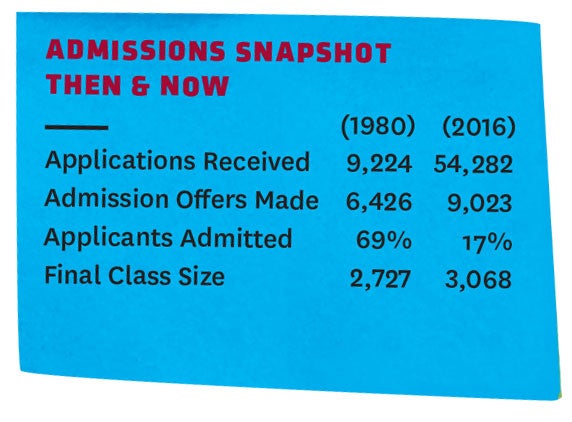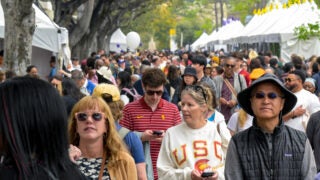An Insider’s Look at USC College Admissions
It gets tougher every year to become a USC undergraduate. Admissions officers demystify the process.
“This is a unique and very special place. For the right student, it can be life-changing.” So says Katharine Harrington PhD ’93, USC’s vice president of admissions and planning. As USC’s chief enrollment officer for the last decade, she has watched the university steadily climb to the top tier of American academia. Her eyes still light up as she rattles off the qualities that set USC apart for undergraduate education. “We’re one of only a very few large, highly selective private universities,” she says. On the West Coast, USC is even more unusual: a private research university with strong Division I athletics and lots of school spirit.
The only competition in that niche is Stanford University, and its student body is far smaller.
Add to the equation Los Angeles — which is elbowing its way into the top ranks of global cities while retaining its century-old status as the entertainment capital of the world—and you start to see why prospective students flock to the USC Admission Center to tour the campus and learn about the admission process.
“We get an awful lot more applicants than most private universities,” Harrington says.
In 2016, that count passed 54,000.
Only 3,068 became Trojans.
BEYOND THE NUMBERS
In 1980, fewer than 10,000 high school seniors applied for admission to USC. Fast forward three decades, and the size of the applicant pool has more than quintupled.
Competition is fierce, and not just at USC. Experts note that the ease of applying to college electronically through the Common Application — as well as anxiety about getting into schools — means that typical high school seniors today apply to many more universities than their 1980s counterparts. More seniors are choosing to go on to college, instead of immediately entering the working world, and among USC applicants, test scores and grade point averages have climbed dramatically.
We get an awful lot more applicants than most private universities.
Katharine Harrington
But the size of USC’s freshman class has remained about the same over this period. It still numbers between 2,700 and 3,000 in any given year. The chances of any one USC applicant being admitted has plummeted from 69 percent in 1980 to less than 17 percent in 2016.
So what makes for a successful application?
“Academic ability is the ante to get into the game,” says Harrington, who is also a professor of clinical management and organization at the USC Marshall School of Business. “It’s the first condition, but it doesn’t guarantee anything.”
Forget the myth that admission is all about the numbers. Says Timothy Brunold ’92, USC’s dean of admission: “This year, we turned away 3,000 people with 99th percentile test scores. We just don’t have enough room.”
An embarrassment of riches is a good problem to have, but a challenge nonetheless.
Prospective students can apply to 14 USC schools and programs, from the USC Dornsife College of Letters, Arts and Sciences to the USC Thornton School of Music.
CAREFUL CURATION
Each year, it’s up to Brunold, who has spent his entire professional life in admissions at USC, to “curate” the freshman class.
It isn’t enough for his team of 45 full-time readers to identify the year’s top 9,000 applicants. Staff members look for a mix of students who will help further the university’s mission of advancing knowledge through teaching, research, artistic creation, professional practice and public service. The team must fulfill a responsibility to deans and faculty to fill their classrooms with students whom, as Brunold puts it, they’ll find “compelling.”
Those freshmen must be distributed across more than a dozen bachelor’s degree-granting schools at USC “in a very particular way, with very particular characteristics,” he adds. Only 33 percent of USC freshmen are based in the USC Dornsife College of Letters, Arts and Sciences. Nearly half will earn degrees in engineering, business or one of USC’s six art schools. Of course, plans change; about 60 percent of Trojan undergrads will switch majors at least once, and 30 percent will change to a major housed in a different USC school. Curating the freshman class also means anticipating how many of the admitted students will enroll (it’s usually about a third).
Admission work has always been both an art and a science, but it has tilted hard toward science in recent years. “We used to go largely with our gut feelings, and those feelings are still valid. But now they have to be verified, justified and explained,” Brunold says.
 Given this complicated matrix of experience, intuition and big data, it might seem like applicants can’t do much to tip the scale in their favor. But they have more control than they know, he says.
Given this complicated matrix of experience, intuition and big data, it might seem like applicants can’t do much to tip the scale in their favor. But they have more control than they know, he says.
Students choose how hard they work in high school. They choose their list of colleges. They choose how much effort they put into their application. They decide what to write in their essays, what to say during the interview, and whom to ask for letters of recommendation.
“Now, they may not get into USC,” Brunold says, “and that’s scary. I get it. No one likes to be judged or rejected.” But, he insists, there’s no secret formula. “They’re trying to decode some equation that doesn’t actually exist.” He urges them to try candor and authenticity. “For those young people who can find a way to believe us, and trust us, and say: ‘Here’s who I am, warts and all,’ it’ll go a lot better.”
A UNIQUE GAME PLAN
Curating a great freshman class starts with identifying great students.
USC’s admissions professionals don’t sit back and wait for a flood of applications to arrive. Instead, they recruit aggressively, well before application deadlines loom. They visit 2,200 high schools a year, three times more than any other university. Brunold spends up to 60 nights a year on the road, traveling from Nashville to Mumbai to Hong Kong and beyond. “The class is not the way it is by chance. It’s because we have constructed it to be that way,” he says. “If we want more of a certain type of student, we have got to go find that student.”
Aggressively recruiting students greatly increases the admissions staff’s workload, and some universities have responded by automating parts of their application screening system. But USC admissions officers evaluate applications the old-fashioned way: They read them. “Every shred of information, every document, every printed page is read multiple times,” Brunold says. From November through March, Brunold’s staff collectively spends more than 35,000 hours poring over these files.
“We really do give all our applicants a holistic review,” Harrington says. “We give every single application our complete attention. We are enormously respectful of the process that students and families go through when they apply to USC.”
As spaces get filled, the tension rises.
“March, when we’re making very difficult decisions, is a tough time,” Brunold says. “People around the office can be short with each other, we lose sleep over this. We absolutely do. There are sometimes hard feelings and strong words. These are fantastic young people. … If it’s easy to deny someone, I often say, then we’re not doing it right.”
Once offers are made, USC admissions counselors pivot from vetting candidates to urging prospects to commit to USC.
“In the month of April, we’ll host 55 events all over the world, doing everything we can to convert those admitted students to enrolled students,” Harrington says. Events include one-day programs on campus for students and families to meet with staff, sit in on classes and learn about financial aid. For those who can’t make the trip, financial aid and academic representatives host receptions in major cities like New York and Shanghai to meet students and answer questions.
And the cycle continues year after year, with a new batch of applications arriving each winter.
“It gets in your blood,” Brunold says. “Helping young people find their way is noble, and it’s optimistic work. I get to meet some of the best and brightest.”



